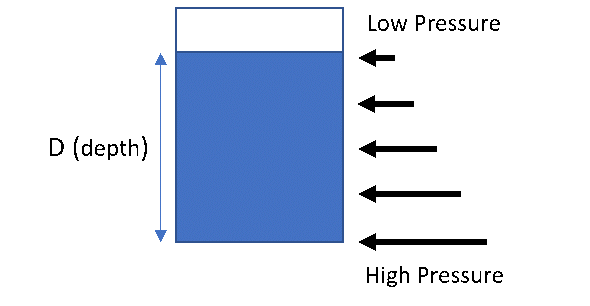When we are performing an finite element analysis of pressure vessel, storage tanks, agitators etc. we are always looking for ways to apply loads due to internal pressure of liquid stored inside the tank which constantly applies the pressure on the inner side of the shell. Applying Hydro-static pressure is the best and more reliable option in FEA, this method increases the accuracy of our results and reduces the overall computational expense required for simulation.
One of the example of this is the ability to estimate the pressure gradient of the liquid filled tank from bottom to top, for example without the need to actually model the fluid. In this blog post, we will discuss about the method apply hydro-static pressure in FEA.
How Hydro-static pressure is defined –
Hydrostatic pressure is the force exerted per unit area and it is based on the acceleration due gravity acceleration of a fluid which is contained inside the enclosure. The deeper the enclosure is filled with fluid, the higher the pressure that it exerts onto the shell of the tank – as well as everything in it. Pressure difference increases linearly from the surface of the fluid to the bottom of the tank. The image below shows the pressure gradient with respect to the depth of the tank, the density of the fluid also plays a major role in the pressure exertion on the shell of the tank.

Why modelling Hydro-static pressure in FEA is important?
Simulating hydrostatic pressure is extremely important for safety measures when structures, tanks, vessels, containers if subjected to liquid loading that they are expected to see in their service life. For example, If oil storage tanks are unable to hold its liquid load as well as any other additional pressure, the shell of the tank or container will simply burst. Using FEA methods one would need to validate hydrostatic pressure to understand the amount of stress and displacement a structure will undergo from this liquid loading.
Unfortunately, this hydrostatic pressure estimation method does have some limitations when the liquid density is not constant throughout the volume of the tank.
Conclusion
Hydrostatic pressure modelling in FEA is simple yet reliably accurate way to represent fluid loads on shell due to internal pressure. This method will work regardless to the shape of the container, tank or structure. However there are some limitations as to how you can use it in FEA, depending on type of material or liquid density. Additionally, the model has to be correctly oriented otherwise the loading would be incorrect. Despite their limitations, hydrostatic pressure modelling is considered a highly reliable method for simulating liquid behavior and has been validated thoroughly via field testing.
We at, Graphler Technology Solutions provide expert FEA services , CAD Conversion Services with engineering prospects and quality. We offer the best solutions to build, develop and optimize the products.


